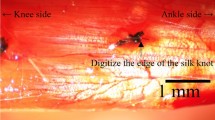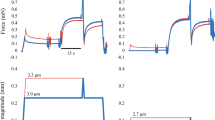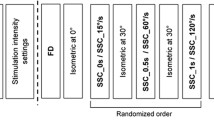Abstract
This study investigated the effects of myofascial force transmission during dynamic shortening of head III of rat extensor digitorum longus muscle (EDL III). The anterior crural compartment was left intact. Force was measured simultaneously at the distal EDL III tendon, the proximal EDL tendon and the distal tendons of tibialis anterior and extensor hallucis longus muscles (TA+EHL). Two types of distal shortening of EDL III were studied: (1) sinusoidal shortening (2 mm) and (2) isokinetic shortening (8 mm). Sinusoidal shortening of EDL III caused a decrease in force exerted at the distal tendon of EDL III: from 0.58 (0.08) N to 0.26 (0.04) N. In contrast, hardly any changes in proximal EDL force and distal TA+EHL force were found. Maximal concentric force exerted at the distal tendon of EDL III was higher than maximal isometric force expected on the basis of the physiological cross-sectional area of EDL III muscle fibers (Maas et al. 2003). Therefore, a substantial fraction of this force must originate from sources other than muscle fibers of EDL III. Isokinetic shortening of EDL III caused high changes in EDL III force from 0.97 (0.15) N to zero. In contrast, changes in proximal EDL force were much smaller: from 2.44 (0.25) N to 1.99 (0.19) N. No effects on TA+EHL force could be shown. These results are explained in terms of force transmission between the muscle belly of EDL III and adjacent tissues. Thus, also in dynamic muscle conditions, muscle fiber force is transmitted via myofascial pathways.





Similar content being viewed by others
References
Armstrong TJ, Buckle P, Fine LJ, Hagberg M, Jonsson B, Kilbom A, Kuorinka IA, Silverstein BA, Sjogaard G, Viikari-Juntura ER (1993) A conceptual model for work-related neck and upper-limb musculoskeletal disorders. Scand J Work Environ Health 19:73–84
Balice-Gordon RJ, Thompson WJ (1988) The organization and development of compartmentalized innervation in rat extensor digitorum longus muscle. J Physiol 398:211–231
Ettema GJC, Huijing PA (1989) Properties of the tendinous structures and series elastic component of EDL muscle-tendon complex of the rat. J Biomech 22:1209–1215
Forde MS, Punnett L, Wegman DH (2002) Pathomechanisms of work-related musculoskeletal disorders: conceptual issues. Ergonomics 45:619–630
Fritz N, Schmidt C (1992) Contractile properties of single motor units in two multi-tendoned muscles of the cat distal forelimb. Exp Brain Res 88:401–410
Hill AV (1938) The heat of shortening and the dynamic constants of muscle. Proc Roy Soc (Lond) B 126:136–195
Huijing PA, Baan GC (2001a) Extramuscular myofascial force transmission within the rat anterior tibial compartment: proximo-distal differences in muscle force. Acta Physiol Scand 173:297–311
Huijing PA, Baan GC (2001b) Myofascial force transmission causes interaction between adjacent muscles and connective tissue: effects of blunt dissection and compartmental fasciotomy on length force characteristics of rat extensor digitorum longus muscle. Arch Physiol Biochem 109:97–109
Huijing PA, Baan GC (2003) Myofascial force transmission: muscle relative position and length determine agonist and synergist muscle force. J Appl Physiol 94:1092–1107
Huijing PA, Baan GC, Rebel GT (1998) Non-myotendinous force transmission in rat extensor digitorum longus muscle. J Exp Biol 201:683–691
Jaspers RT, Brunner R, Baan GC, Huijing PA (2002) Acute effects of intramuscular aponeurotomy and tenotomy on multitendoned rat EDL: indications for local adaptation of intramuscular connective tissue. Anat Rec 266:123–135
Kawakami Y, Huijing PA, Ito M, Muraoka Y, Kubo K, Fukunaga T (2004). In vivo myofascial force transmission between passive EDL muscle segments in humans. 14th Biennal Meeting of the European Society of Biomechanics, The Netherlands
Kreulen M, Smeulders MJC, Hage JJ, Huijing PA (2003) Biomechanical aspects of progressive flexor carpi ulnaris muscle dissection. J Bone Joint Surg [Br] 85:856–859
Maas H (2003) Myofascial force transmission: intra-, inter- and extramuscular pathways. Faculty of Human Movement Sciences. Vrije Universiteit, Amsterdam
Maas H, Baan GC, Huijing PA (2001) Intermuscular interaction via myofascial force transmission: effects of tibialis anterior and extensor hallucis longus length on force transmission from rat extensor digitorum longus muscle. J Biomech 34:927–940
Maas H, Jaspers RT, Baan GC, Huijing PA (2003a) Myofascial force transmission between a single muscle head and adjacent tissues: length effects of head III of rat EDL. J Appl Physiol 95:2004–2013
Maas H, Yucesoy CA, Baan GC, Huijing PA (2003b) Implications of muscle relative position as a co-determinant of isometric muscle force: a review and some experimental results. J Mech Med Biol 3:145–168
Maas H, Baan GC, Huijing PA, Yucesoy CA, Koopman BH, Grootenboer HJ (2003c) The relative position of EDL muscle affects the length of sarcomeres within muscle fibers: experimental results and finite element modeling. J Biomech Eng 125:745–753
Maas H, Baan GC, Huijing PA (2004) Muscle force is determined also by muscle relative position: isolated effects. J Biomech 37:99–110
Sandercock TG (2000) Nonlinear summation of force in cat soleus muscle results primarily from stretch of the common-elastic elements. J Appl Physiol 89:2206–2214
Schieber MH (1995) Muscular production of individuated finger movements: the roles of extrinsic finger muscles. J Neurosci 15:284–297
Smeulders MJC, Kreulen M, Huijing PA (2003) Inter- and extramuscular connections determine muscle properties in spastic patients by myofascial force transmission. International Society of Biomechanics XIXth Congress, Dunedin, New Zealand, University of Otago
Visser B, Dieën JHv (2004) Pathophysiology of work related upper extremity muscle disorders. J Electromyogr Kinesiol (in press)
Willems ME, Stauber WT (1999) Isometric and concentric performance of electrically stimulated ankle plantar flexor muscles in intact rat. Exp Physiol 84:379–389
Woittiez RD, Brand C, de Haan A, Hollander AP, Huijing PA, van der Tak R, Rijnsburger WH (1987) A multipurpose muscle ergometer. J Biomech 20: 215–218
Acknowledgements
The authors wish to acknowledge the valuable comments of Professor Jaap H. van Dieën on the manuscript.
Author information
Authors and Affiliations
Corresponding author
Rights and permissions
About this article
Cite this article
Maas, H., Huijing, P.A. Myofascial force transmission in dynamic muscle conditions: effects of dynamic shortening of a single head of multi-tendoned rat extensor digitorum longus muscle. Eur J Appl Physiol 94, 584–592 (2005). https://doi.org/10.1007/s00421-005-1367-7
Accepted:
Published:
Issue Date:
DOI: https://doi.org/10.1007/s00421-005-1367-7




